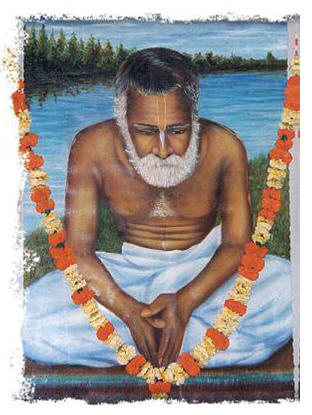Srila Gaura-kisora dasa Babaji Maharaja, the crest-jewel of avadhutas and paramahamsas, performed bhajana from time to time here. He would also perform his bhajana at Krishna’s various pastime-places in Vraja, such as Vrindavana, Govardhana, Radha-kunda, Surya-kunda, Nandagrama and Varsana. His bhajana was characterised by severe renunciation, so extreme, in fact, that when he felt hungry he sometimes ate the mud from Radha-kunda or the Yamuna. In a mood of separation from the Divine Couple, he would cry out, “O Radha! O Krishna!” and wander from forest to forest loudly singing songs such as “kothaya go premamayi radhe radhe, kothaya go vraja-vilasini radhe radhe.” In his later life he came to Sri Navadvipa to get the mercy of this dhama. Srila Gaura-kisora dasa Babaji Maharaja had taken a vow not to accept any disciples, but Sri Vimala Prasada Sarasvati vowed to fast until he received initiation from him. This, combined with the request of Srila Bhaktivinoda Thakura, resulted in Srila Gaura-kisora dasa Babaji Maharaja giving initiation into Vaishnavism to the boy Sarasvati, who became famous in the Vaishnava world as om vishnupada Sri Srimad Bhaktisiddhanta Sarasvati Thakura Prabhupada. Babaji Maharaja regarded honour and prestige harmful to bhajana. He therefore carefully avoided it, considering it to be like the stool of a pig. People would disturb him to receive blessings for their material desires, such as wealth, followers, sons and family. Once, to avoid such materialistic people, Babaji Maharaja went to live in the abandoned latrine in a government dharmasala in Kuliya. When the District Magistrate came to know of this he went to meet him with the Police Superintendent. Babaji had locked the latrine door from inside, and even though they waited for a long time, repeatedly requesting him to open the door, he would not come out to meet with them. They offered to construct a hut for him in a good location, but Babaji Maharaja did not consent to the idea. According to Babaji Maharaja, the association of materialistic people is more disgusting than the stench of excrement, and is an obstacle for bhakti. He later entered his unmanifest pastimes in this same dharmasala.

Once a man approached Srila Babaji Maharaja and repeatedly requested him to bestow his mercy upon him. Babaji Maharaja immediately took off his dora and kaupina [the undergarments of a renunciant], and told him, “Here, take my mercy.” Fearing that he would have to give up material life the man quickly fled.
Another incident involved a young man who referred to himself as Babaji’s disciple and who lived near his asrama. After some days he returned to his home, married and came back to Babaji Maharaja with his wife. He offered obeisances to Babaji and begged for his auspicious blessings, saying, “Babaji Maharaja, I have collected a maidservant (krishna-dasi ) for Sri Krishna’s service. Please give us your blessings.” Babaji gravely said, “It is a matter of great pleasure that you have established a new house for Krishna and collected a krishnadasi. But, be cautious! Never entertain the thought of personally enjoying her. Never accept any service from her, always think of her as worshipful and always serve her. A krishna-dasi is most respectable and worshipful for the entire universe.” When that young man heard this, he quickly left with his wife.
Once, with great happiness, a so-called babaji gave the following auspicious news to Babaji Maharaja: “I purchased a beautiful place in Sri Navadvipa-dhama. I will build a hut there and perform bhajana.” Hearing this Babaji Maharaja answered, “It is very amazing that you have purchased land in Navadvipa-dhama where every particle of dust is transcendental and millions of times more valuable than a cintamani, a wish fulfilling gem. The entire wealth of the universe cannot compare with the value of just one dust particle of this abode, and you have bought a piece of this land? This is beyond my comprehension.” Ashamed, the man fell at Babaji’s feet.
Previously the samadhi of this great personality was situated in Kuliya-grama (Navadvipa Town) on the Ganga’s western bank, but when the river flooded, Srila Sarasvati Thakura reestablished it next to Radha-kunda close to Sri Candrasekharabhavana. Although, from a worldly point of view, Babaji Maharaja was blind and uneducated, prominent speakers of the Bhagavatam who were his contemporaries would come to hear his confidential and ambrosial explanations of verses from Srimad- Bhagavatam.